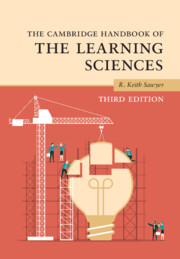Book contents
- The Cambridge Handbook of the Learning Sciences
- The Cambridge Handbook of the Learning Sciences
- Copyright page
- Contents
- Figures
- Tables
- Contributors
- Preface
- 1 An Introduction to the Learning Sciences
- Part I Foundations
- 2 Foundations of the Learning Sciences
- 3 Scaffolding
- 4 Project-Based Learning
- 5 Metacognition and Self-Regulated Learning
- 6 A History of Conceptual Change Research
- 7 Learning in Activity
- 8 Cognitive Apprenticeship
- Part II Methodologies
- Part III Grounding Technology in the Learning Sciences
- Part IV Learning Together
- Part V Learning Disciplinary Knowledge
- Part VI Moving Learning Sciences Research into the Classroom
- Index
- References
7 - Learning in Activity
from Part I - Foundations
Published online by Cambridge University Press: 14 March 2022
- The Cambridge Handbook of the Learning Sciences
- The Cambridge Handbook of the Learning Sciences
- Copyright page
- Contents
- Figures
- Tables
- Contributors
- Preface
- 1 An Introduction to the Learning Sciences
- Part I Foundations
- 2 Foundations of the Learning Sciences
- 3 Scaffolding
- 4 Project-Based Learning
- 5 Metacognition and Self-Regulated Learning
- 6 A History of Conceptual Change Research
- 7 Learning in Activity
- 8 Cognitive Apprenticeship
- Part II Methodologies
- Part III Grounding Technology in the Learning Sciences
- Part IV Learning Together
- Part V Learning Disciplinary Knowledge
- Part VI Moving Learning Sciences Research into the Classroom
- Index
- References
Summary
This chapter presents an approach to the study of learning which analyzes small groups – such as a dyad, a group, a classroom – or large groups – for example, a community or a social movement. This approach is based on a situativity or sociocultural theory of cognition and learning, where learning is “situated” within complex social and material contexts known as activity systems. Sociocultural theories are related to cultural-historical activity theory, situated learning theory, distributed cognition theory, and cultural psychology. These theories suggest that a full account of learning must extend beyond individualist psychology to analyze and explain social practices, technological artifacts, interactional patterns, and the different roles occupied by the participants.
- Type
- Chapter
- Information
- The Cambridge Handbook of the Learning Sciences , pp. 134 - 155Publisher: Cambridge University PressPrint publication year: 2022
References
- 4
- Cited by



